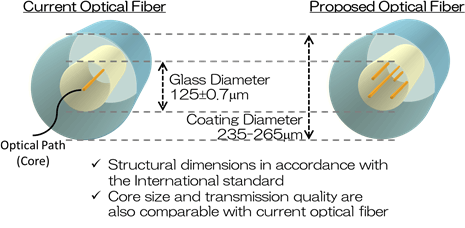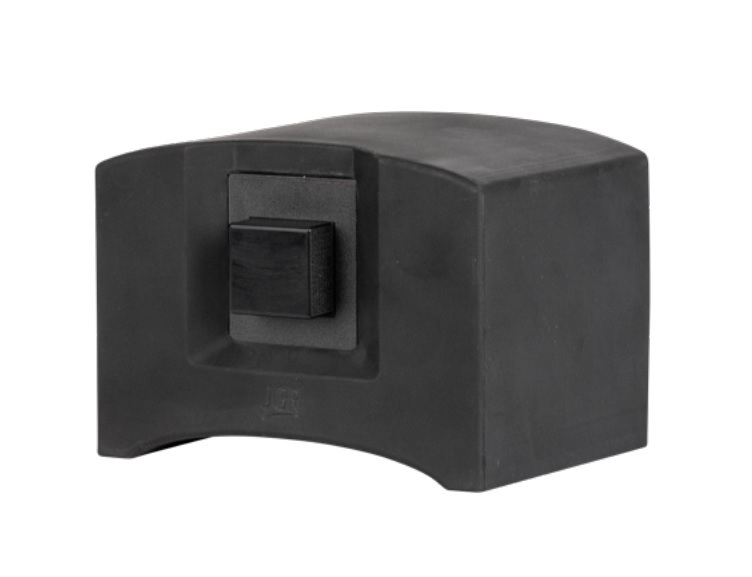8 August, 2017
Nippon Telegraph and Telephone Corporation, and six partners, KDDI Research, Inc., Sumitomo Electric Industries, Ltd., Fujikura Ltd., Furukawa Electric Co., Ltd., NEC Corporation, and Chiba Institute of Technology have demonstrated the world's largest transmission capacity of 118.5 Tera-bit/s using a multi-core fiber with four optical paths (cores) in the same diameter of currently used optical fiber.
A conventional glass diameter (125 µm) in accordance with the international standard enables us to use existing optical fiber fabrication and optical connector technologies effectively. This achievement proves the concept of multi-core fiber based long-haul and large capacity transmission system consisting of multiple vendor technologies, and it makes significant progress on practical use of the multi-core fiber technology.
The researchers aim to introduce the standard diameter multi-core fiber by the early 2020s. We will also continue to contribute the realization of a future optical infrastructure which can support variety of data communication demands.
This remarkable achievement was reported in 4 August as a postdeadline paper at the Opto Electronics and Communications Conference (OECC 2017), the largest conference on optical communication in Asia Pacific-Rim, which was held at Sands Expo and Convention Centre, Singapore.
This work was partially based on work commissioned by the National Institute of Information and Communications Technology (NICT).
World wide spread of various mobile terminal and data services continuously increases the transmission capacity more than 10% per year all over the world. This trend may cause capacity crunch in the currently used optical fiber by the late 2020s. Moreover, the expansion of optical fiber count and the convergence of optical wiring particularly in the data center and/or central office, which is caused by the world wide data capacity increase, would be serious problem.
With these as backgrounds, a multi-core fiber having multiple optical paths (cores) in one fiber has been investigated intensively all over the world in order to overcome the future capacity crunch and to realize the high density or space saving optical facilities. For example, ultra large capacity transmission experiments using a multi-core fiber with 10 cores or more have been demonstrated. However, these high core count multi-core fiber usually needs a thicker glass diameter, and it requires an extreme advance in the fabrication process and further development on sub-components. As a result, it is considered that 10 years or so would be necessary to make the high core count multi-core fiber practical.
In order to accelerate using the multi-core fiber technology, NTT, KDDI Research, Sumitomo Electric, Fujikura, Furukawa, NEC, and CIT developed a multi-core fiber with a conventional diameter in accordance with the current International standard. It enables to use existing optical fiber technology even though it limits the number of cores to 4-5.
During the fabrication process of an optical fiber, a relatively large size glass rod with a diameter of several to ten centimeters, namely preform, is prepared. An optical fiber is realized by melting and drawing the preform while keeping the geometrical similarity. When a glass diameter of an optical fiber is enlarged two times (e.g. from conventional 125 µm to 250 µm), the fabrication length obtained with the same size preform is reduced to a quarter. Therefore, the increase in the glass diameter directly affects the mass-productivity of an optical fiber. The current optical communication system is commonly using a single-mode fiber (SMF) with a core diameter of about 10 µm and it which can be used in all the telecommunication wavelength region (1260 nm – 1625 nm).
The researchers aim to realize a multi-core fiber with two features: i) having a glass and coating diameter of 125±0.7 µm and 235-265 µm in accordance with the International standard of the current optical fiber, ii) whose individual core can have the similar transmission quality with the commonly used SMF. In a multi-core fiber, the optical signal interference between neighboring cores should be reduced sufficiently. NTT and KDDI Research revealed that 4-5 cores can be arranged in a 125 µm glass diameter.
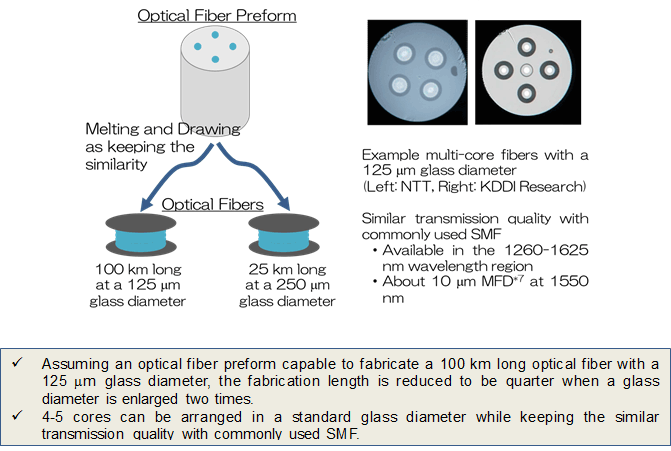
Figure 2 Schematic image of productivity reduction caused by a glass diameter enlargement, and example multi-core fibers with a standard glass diameter
Multi-core transmission line composed of multiple vendor optical fibers
Based on the above design guideline, Sumitomo Electric, Fujikura, and Furukawa individually fabricated a multi-core fibers with four cores and more than 100 km length. All multi-core fibers can be used in the 1260 nm – 1625 nm wavelength region, and having the similar transmission property to the current SMF (cf. Mode filed diameter (MFD) at 1550 nm is 9-10 µm).
The fabricated multi-core fibers were divided into a 20-40 km long pieces, and three transmission spans with a length of 104-107 km were re-constructed by splicing the multi-core fibers provided by different vendors intentionally. A satisfactory low loss features which is comparable to the conventional SMF was achieved. An average loss of four cores in each span was 0.22 dB/km or less including splicing losses. We spliced two multi-core fibers by melting each end, namely fusion splice technology. A 0.21 dB/km loss property was achieved as the average of all three spans.
These achievements indicate that our standard diameter multi-core fiber with similar transmission quality (MFD) with the conventional SMF enables us to greatly improve the productivity of the multi-core fiber made by the effective use of the existing fabrication technology and knowledge.
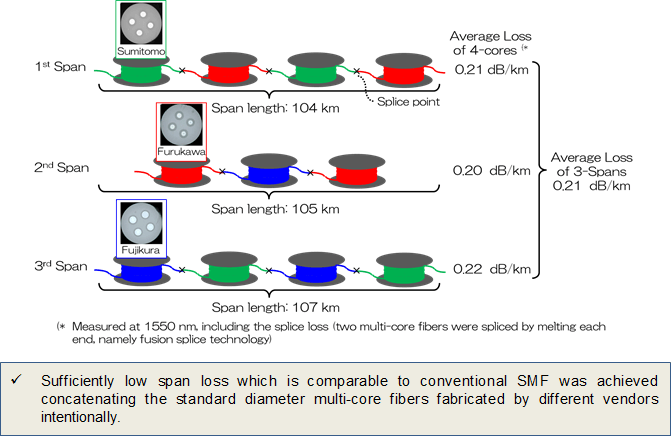
Figure 3 Schematic image of multi-core transmission line composed of different vendors and its loss characteristics
Beyond 100 Tera-bit transmission
A multi-core transmission system was constructed by concatenating three spans. Three multi-core optical amplifiers fabricated by NEC, KDDI Research, NTT, and Furukawa were inserted at each end of three spans in order to compensate the signal attenuation. Cladding pumping type multi-core optical amplifiers which is expected to reduce power consumption were used, and a 16% improvement was confirmed in this achievement. In order to confirm the capability of the constructed multi-core transmission line to beyond 100 Tera-bit/s transmission, 16QAM based 116-wavelength signals were prepared and the output signal quality after 316 km long transmission were examined.
Fan-In/Fan-Out devices fabricated by NTT and Furukawa were used to input/output signals to/from each core of multi-core fiber. Pluggable optical connectors with existing MU-type or SC-type interfaces, fabricated by CIT and NTT, were used to connect the input/output end of the multi-core transmission lines and Fan-In/Fan-Out devices. These optical connectors have rotational alignment features in order to connect the facing four-cores correctly. Thus, the low loss and pluggable optical connection of multi-core structure was achieved.
Satisfactory well transmission quality was confirmed in all cores and all wavelengths, this result is the world's largest transmission capacity of 118.5 Tera-bit/s among a standard diameter optical fiber. These achievements reveal that multi-core fiber with standard diameter can be used to realize an ultra large capacity transmission system overcoming the capacity crunch in the current SMF.

Figure 4 Example of transmission experiments among a standard diameter optical fiber
The present achievement indicates that a multi-core fiber with the standard diameter can be used to realize a transmission capacity of more than 100 Tera-bit/s while enabling the productivity improvement and effective use of the existing technology. This achievement is expected to open up earlier practical use of the multi-core fiber technology.
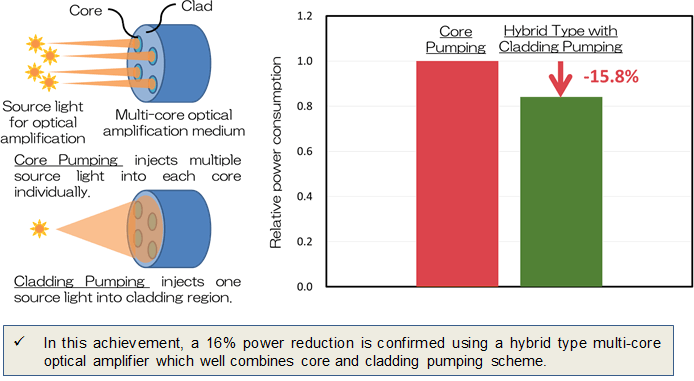
Figure 5 Image of a cladding pump based multi-core optical amplifier and experimental result for power consumption reduction
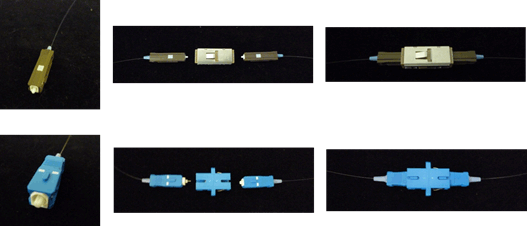
Figure 6 Overview photos and optical connection image of MU-type (top) and SC-type (bottom) optical connectors.

Figure 7 Transmission performance of 16QAM based 116-wavelengths after a16-km transmission.
The researchers aim to introduce the standard diameter multi-core fiber by the early 2020s. We will also continue to contribute the realization of a future optical infrastructure which can support variety of data communication demand.

